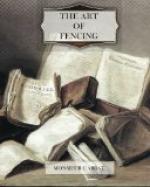Secondly, Seconde may be parryed by making a Half-circle on the Outside, the Wrist in Quart, as high as the Shoulder, the Arm extended, and the Point very low. See the 7th Plate. It is less dangerous, and more easy for the Rispost than the former, which must be made as soon as you have parryed, by pushing strait in Quart which the Adversary having pushed under, can hardly avoid, but by yeilding, and battering the Sword. See the 7th Plate.
To this Manner of parrying Seconde, there is but one Opposite, which is done by feinting below, and as the Adversary is going to cross your Sword, in order to parry, you must disengage by a little Circle, with the Hand in Seconde, which preventing the Enemy’s Sword, gives an Opportunity of hitting him above, if the Wrist is lower than I have observed, or in Flanconnade, if the Wrist is high. A Man that parrys below, in order to avoid this Feint, must redouble his Circle to meet the Blade. This Parade is best in recovering, after having pushed, not only to avoid the strait or low Rispost, but also any Feint or Thrust.
The third and best Parade, is made with your Fort to the Middle of the Adversary’s Sword, the Wrist turned in Quart, but a little lower: The Rispost of this Parade is very good, when you know how to bind the Sword upon the Rispost; and it cannot be parryed without returning to the Parade that I have here, before, described and which, I believe, is peculiar to myself.
This Parade is by so much the more adventageous, as the Rispost is easy the Sword being near the Adversary’s Body, which makes it, more difficult for him to avoid you; besides, by this Parade, you are in better Condition to parry, not only a Thrust below, but also any other Thrusts and Feints, the Sword being near the Situation of Guard.
CHAP. VIII.
Of Quart under the Wrist.
This Thrust should not be made but instead of Seconde, that is to say, on an Engagement, Parade, or Lunge of the Adversary in Quart.
The Wrist must not be so much turned up, nor so high as in Quart within; the Body should be more inward, and bending more forward. (Refer to the 7th Plate.)
In case the Adversary pushes Quart, in order to take the Time, you must lunge the Foot strong inward, to throw the Body farther from the Line of the Adversary’s Sword.
In recovering from this Thrust, the Wrist must be in Tierce, and the Sword without the Enemy’s whilst the other Parts take their Situation.
The Parade of this Thrust is made by a Half-circle of the Sword within, the Wrist raised in Quart, and the Point low. See the 7th Plate.
[Illustration: 7th Plate. Thrust under the Wrist.]
[Illustration: It’s Parade.]




